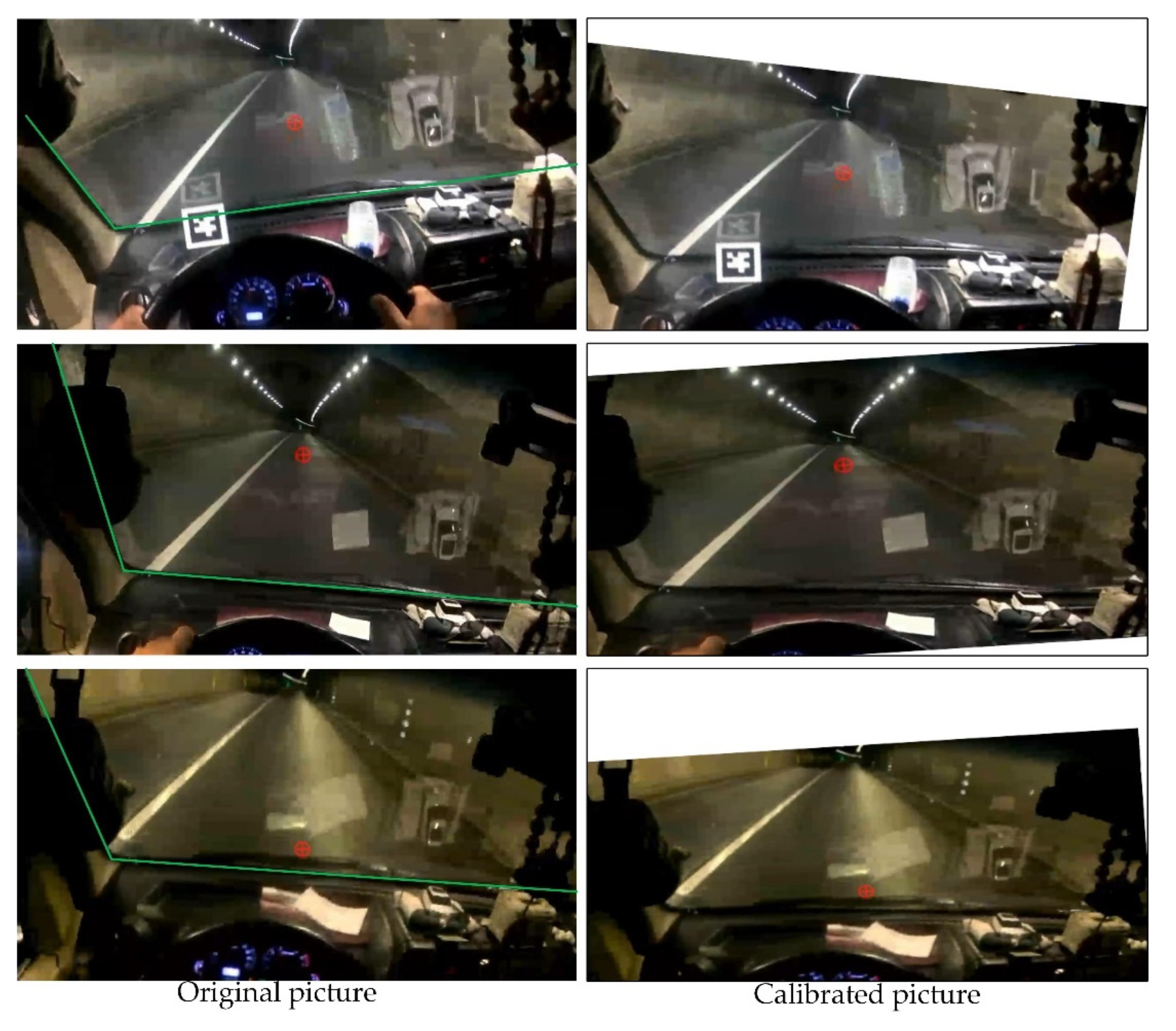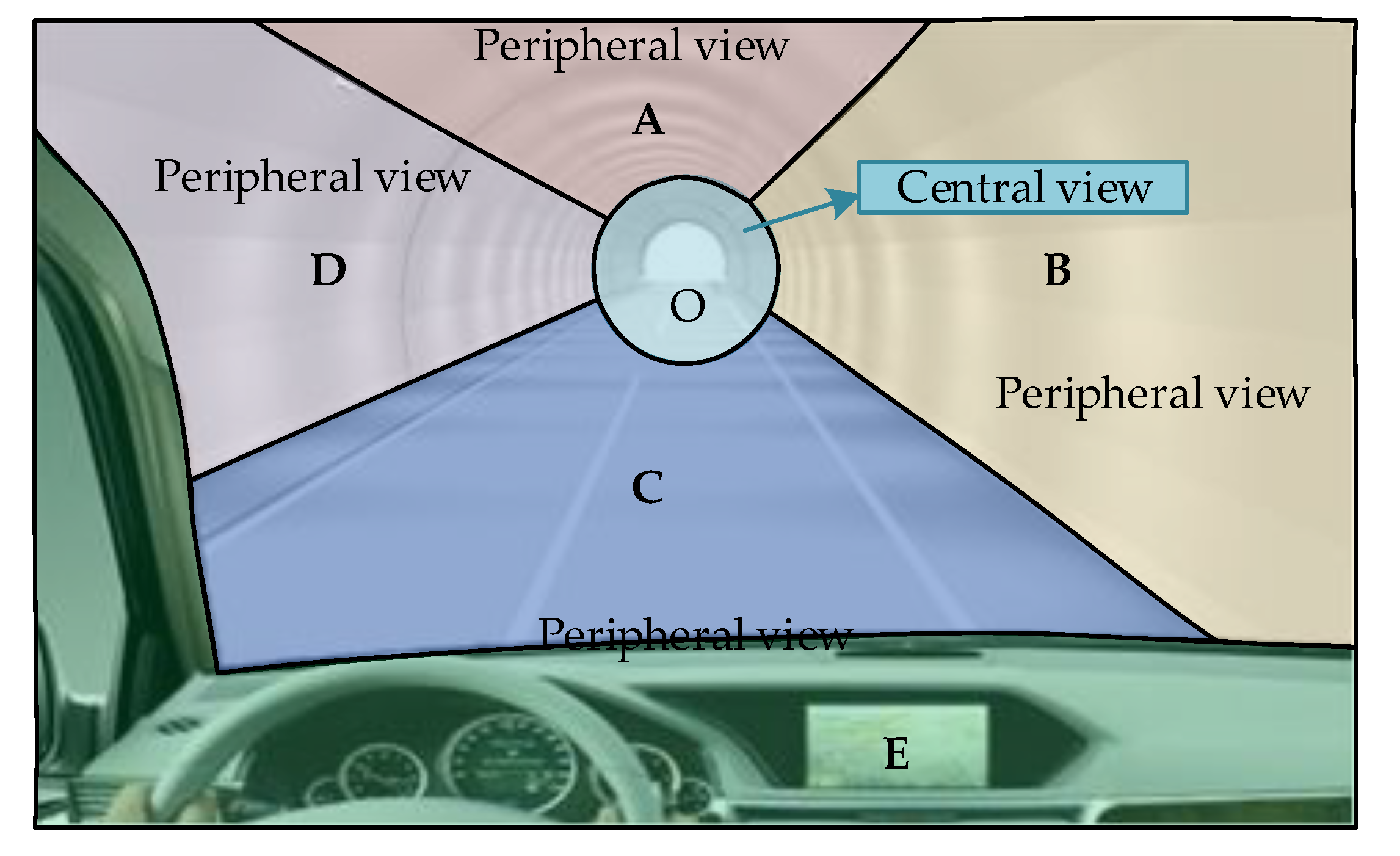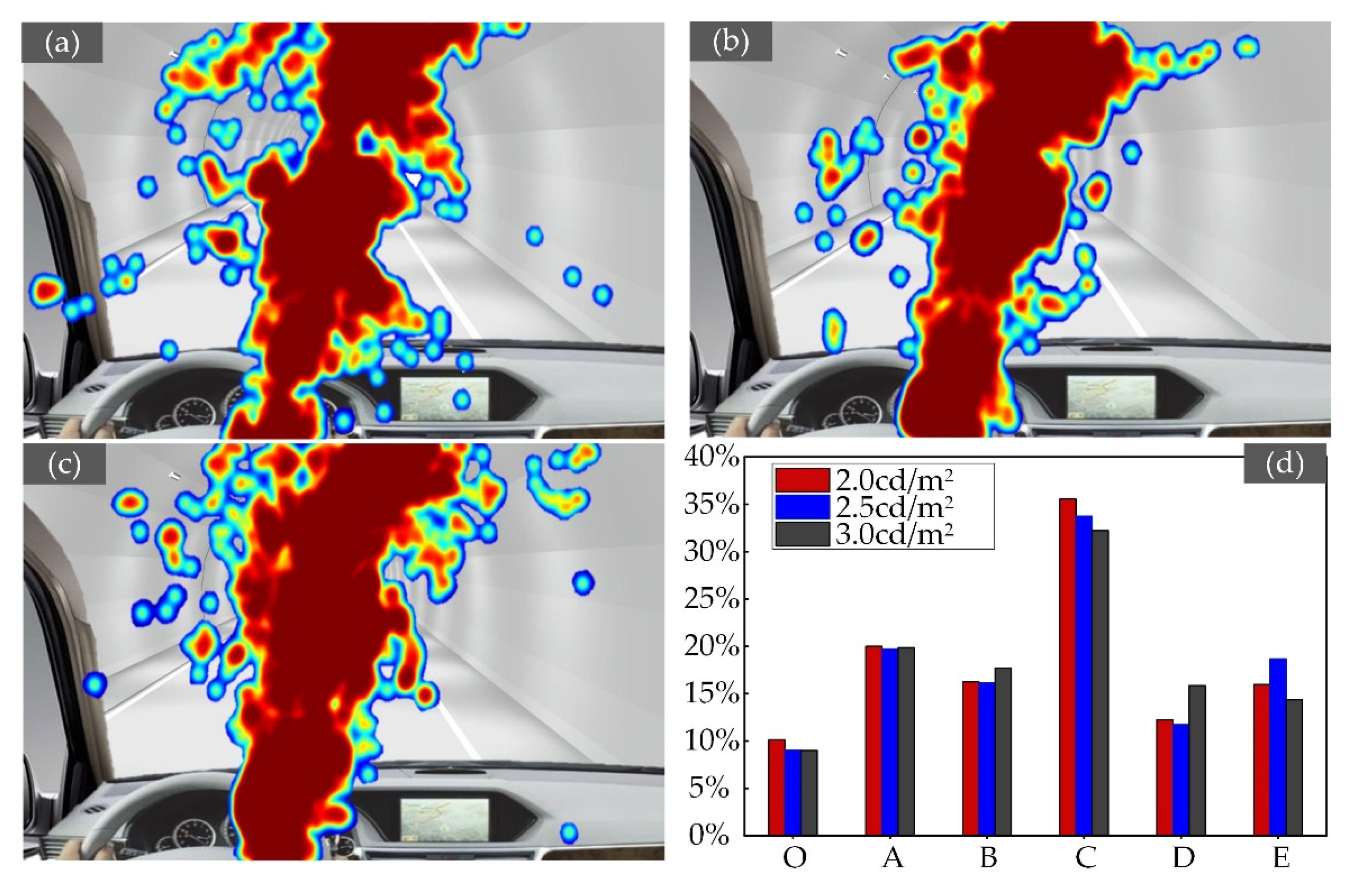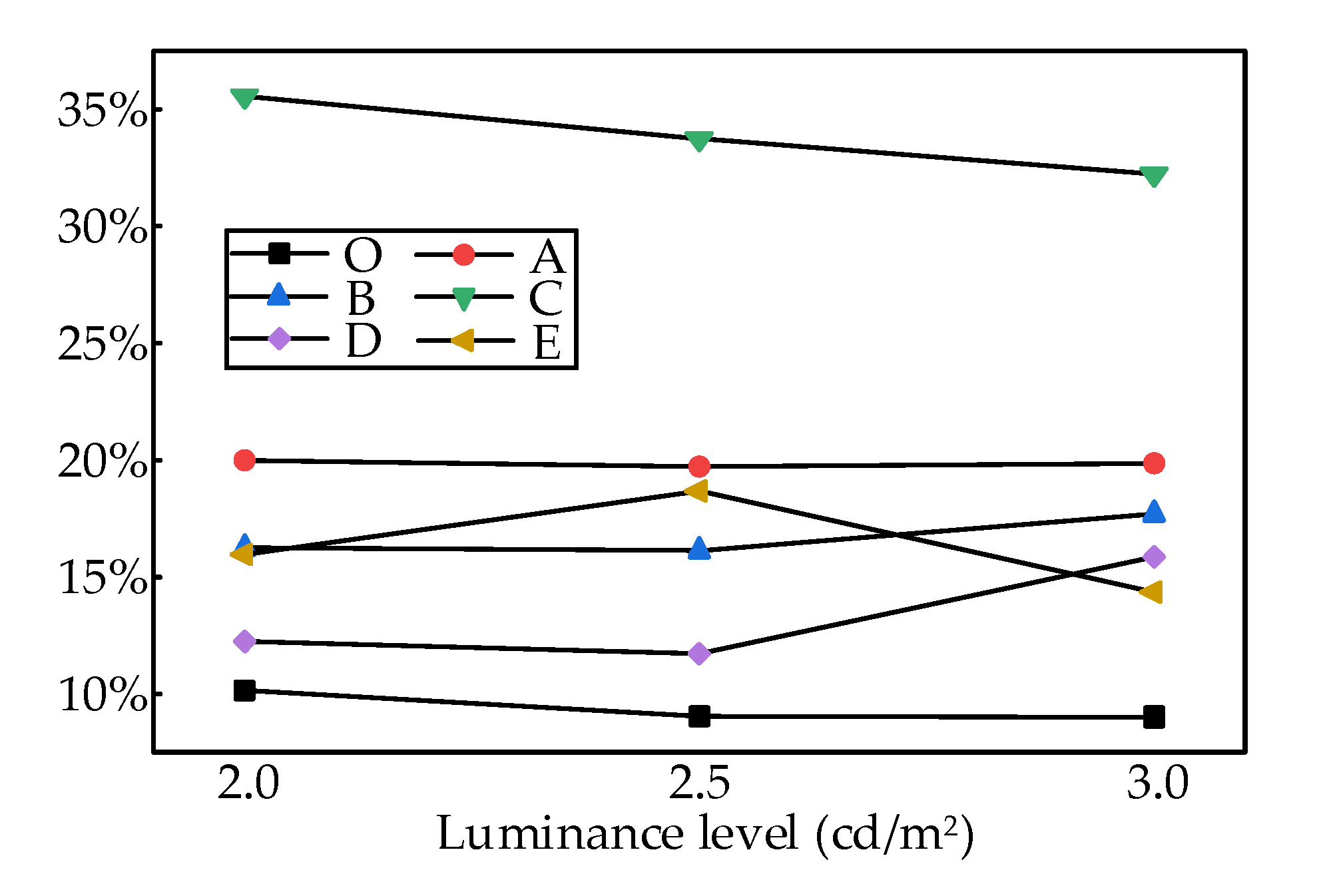Use of Pupil Area and Fixation Maps to Evaluate Visual Behavior of Drivers inside Tunnels at Different Luminance Levels—A Pilot Study
Abstract
:1. Introduction
2. Literature Review
3. Materials and Methods
3.1. Test Participants
3.2. Driving Scenario and Environment
3.3. Experimental Instrument and Vehicle
3.4. Experimental Procedure
- (1)
- Before testing, each participant was briefed on the objectives and procedures of the experiment. Also, each participant was familiar with the test vehicle before the test.
- (2)
- The participant drove the vehicle to the starting point, checked the test equipment, such as laptop, power supply, and eye tracker, and the experimenter connected the eye tracker to the laptop.
- (3)
- Before the former test, the experimenter helped the driver put on an eye tracker and adjusted the eye tracker pupil lens and the scene lens to the most comfortable angle under normal working conditions.
- (4)
- The experimenter calibrated the eye tracker, and the participants adjusted their bodies to a comfortable sitting position and kept their heads as still as possible during the test.
- (5)
- During the test, the experimenter checked the work of the eye tracker in real-time and corrected the abnormal data timely. As the vehicle drove out of the tunnel, test data collection stopped, thus text and video data were saved.
- (6)
- After the driver completed the experimental test for a luminance level, the experimenter would check the accuracy of eye-movement data. If there was a problem with the data, the experiment would be redone starting from step (4), after a brief break. The experiment was repeated for the three predetermined luminance levels starting from step (2).
- (7)
- Once a participant completed the experiments for the three luminance levels, the next participant would perform the tests starting from step (2). It is worth mentioning that all six drivers completed the experiments in strict accordance with the above steps.
4. Results and Analysis
4.1. Pupil Area
4.1.1. Data Preprocessing
4.1.2. Pupil Area Analysis
4.2. Fixation
4.2.1. Data Preprocessing
4.2.2. Fixation Maps Analysis
- Region A (upper region): it represents the top wall;
- Region B (right region): it represents the right interior wall;
- Region C (lower region): it represents the road surface;
- Region D (left region): it mainly includes the left interior wall;
- Region E (dashboard): it mainly includes Vehicle’s Instrument Panel/Car Dashboard.
5. Conclusions
- (1)
- When driving through the tunnel interior zone, the pupil area remains at a relatively stable level. The results showed that the luminance level had a significant effect on the drivers’ eye movement indicators, pupil area, and fixation point position.
- (2)
- The average pupil area was negatively correlated with luminance level, which implies that the driver’s dynamic visual acuity can be improved by reducing his pupil area, which in turn increases his ability to identify moving objects. Moreover, the relationship between pupil area and luminance level fitted a linear function.
- (3)
- When driving in the tunnel, the participants’ fixation areas are mainly on the front road pavement, on the top wall surface, and on the dashboard. The results revealed that the road pavement is the most important region for drivers in the tunnel’s interior zone.
- (4)
- Although the study presented some promising practices, the study also has limitations. The main limitation is the small sample size (i.e., 6 drivers). Future studies should increase the number of drivers to confirm the results. Also, future studies should be carried out under different weather conditions. Furthermore, the tests should distinguish between the novice subjects and the experienced subjects, male and female subjects, in addition to other parameters.
Author Contributions
Funding
Institutional Review Board Statement
Informed Consent Statement
Data Availability Statement
Conflicts of Interest
References
- Tsai, M.-S.; Lee, X.-H.; Lo, Y.-C.; Sun, C.-C. Optical design of tunnel lighting with white light-emitting diodes. Appl. Opt. 2014, 53, H114–H120. [Google Scholar] [CrossRef]
- Makarov, V.V. Island Megalopolises: Tunnel Systems as a Critical Alternative in Solving Transport Problems. Engineering 2018, 4, 138–142. [Google Scholar] [CrossRef]
- Qin, L.; Shi, X.; Leon, A.S.; Tong, C.; Ding, C. Dynamic luminance tuning method for tunnel lighting based on data mining of real-time traffic flow. Build. Environ. 2020, 176, 106844. [Google Scholar] [CrossRef]
- Transportation Department. Statistical Bulletin on the Development of the Transportation Industry in 2020. Available online: https://xxgk.mot.gov.cn/2020/jigou/zhghs/202105/t20210517_3593412.html (accessed on 19 May 2021).
- Robatsch, K.; Nussbaumer, C. Comparative analysis of safety in tunnel. In Proceedings of the Young Researchers Seminar, Brno, Czech Republic, 27–30 May 2007. [Google Scholar]
- Amundesen, F.H.; Engelbrektsen, A. Studies on Norwegian Road Tunnels II. An Analysis on Traffic Accidents in Road Tunnels; Vegdirektoratet, Road and Traffic Department, Traffic Department, Traffic Safety Section: Oslo, Norway, 2009. [Google Scholar]
- Caliendo, C.; De Guglielmo, M.L. Accident Rates in Road Tunnels and Social Cost Evaluation. Procedia Soc. Behav. Sci. 2012, 53, 166–177. [Google Scholar] [CrossRef] [Green Version]
- Ma, Z.-L.; Shao, C.-F.; Zhang, S.-R. Characteristics of traffic accidents in Chinese freeway tunnels. Tunn. Undergr. Space Technol. 2009, 24, 350–355. [Google Scholar] [CrossRef]
- Carvel, R.; Marlair, G. A History of Fire Incidents in Tunnels. In The Handbook of Tunnel Fire Safety; Beard, A.N., Marlair, G., Eds.; ICE Publishing: London, UK, 2005; pp. 3–41. [Google Scholar]
- Ni, H.L.; Dai, Y.H.; Zhao, Q.X. Research on distribution characteristics of traffic accidents in expressway tunnel. Highway 2010, 4, 126–129. [Google Scholar]
- Han, X.; Shao, Y.; Pan, B.; Yu, P.; Li, B. Evaluating the impact of setting delineators in tunnels based on drivers’ visual characteristics. PLoS ONE 2019, 14, e0225799. [Google Scholar] [CrossRef] [Green Version]
- Zhang, W.; Dai, J.; Pei, Y.; Li, P.; Yan, Y.; Chen, X. Drivers’ Visual Search Patterns during Overtaking Maneuvers on Freeway. Int. J. Environ. Res. Public Health 2016, 13, 1159. [Google Scholar] [CrossRef] [PubMed] [Green Version]
- Qin, L.; Dong, L.-L.; Xu, W.-H.; Zhang, L.-D.; Leon, A.S. Influence of Vehicle Speed on the Characteristics of Driver’s Eye Movement at a Highway Tunnel Entrance during Day and Night Conditions: A Pilot Study. Int. J. Environ. Res. Public Health 2018, 15, 656. [Google Scholar] [CrossRef] [Green Version]
- Chang, X.; Li, H.; Rong, J.; Qin, L.; Zhao, X. Spatiotemporal Characteristics of Vehicle Trajectories in a Connected Vehicle Environment—A Case of an Extra-Long Tunnel Scenario. IEEE Syst. J. 2020, 1–12. [Google Scholar] [CrossRef]
- Kinateder, M.; Pauli, P.; Müller, M.; Krieger, J.; Heimbecher, F.; Rönnau, I.; Bergerhausen, U.; Vollmann, G.; Vogt, P.; Mühlberger, A. Human behaviour in severe tunnel accidents: Effects of information and behavioural training. Transp. Res. Part F Traffic Psychol. Behav. 2013, 17, 20–32. [Google Scholar] [CrossRef]
- Kowler, E. Eye movements: The past 25years. Vis. Res. 2011, 51, 1457–1483. [Google Scholar] [CrossRef] [Green Version]
- Ren, Y.-Y.; Li, X.-S.; Zheng, X.-L.; Li, Z.; Zhao, Q.-C. Analysis of Drivers’ Eye-Movement Characteristics When Driving around Curves. Discret. Dyn. Nat. Soc. 2015, 2015, 462792. [Google Scholar] [CrossRef]
- Li, S.-W.; Ji, B.-K.; Sun, W.-C.; Wang, L.-H.; Yang, Z.-K. Study on the Influence of Driving Experience on Visual Characteristic. Adv. Mech. Eng. 2013, 5, 1–7. [Google Scholar] [CrossRef] [Green Version]
- Yan, Y.; Yuan, H.; Wang, X.; Xu, T.; Liu, H. Study on driver’s fixation variation at entrance and inside sections of tunnel on highway. Adv. Mech. Eng. 2015, 7, 273427. [Google Scholar] [CrossRef]
- Sivak, M. The Information That Drivers Use: Is it Indeed 90% Visual? Perception 1996, 25, 1081–1089. [Google Scholar] [CrossRef]
- Mannering, F. The effect of interstate speed limits on driving speeds: Some new evidence. In Proceedings of the 86th Annual Meeting of the Transportation Research Board, Washington, DC, USA, 21–25 January 2007. Paper No. 07-0120. [Google Scholar]
- Ferdinando, S.; Iacopo, G.; Simone, B. Energy optimization of road tunnel lighting systems. Sustainability 2015, 7, 9664–9680. [Google Scholar]
- Kircher, K.; Ahlstrom, C. The impact of tunnel design and lighting on the performance of attentive and visually distracted drivers. Accid. Anal. Prev. 2012, 47, 153–161. [Google Scholar] [CrossRef] [PubMed]
- Underwood, G.; Chapman, P.; Brocklehurst, N.; Underwood, J.; Crundall, D. Visual attention while driving: Sequences of eye fixations made by experienced and novice drivers. Ergonomics 2003, 46, 629–646. [Google Scholar] [CrossRef]
- Xu, C.; Liu, P.; Wang, W.; Li, Z. Evaluation of the impacts of traffic states on crash risks on freeways. Accid. Anal. Prev. 2012, 47, 162–171. [Google Scholar] [CrossRef]
- Wen, H.; Sun, J.; Zeng, Q.; Zhang, X.; Yuan, Q. The effects of traffic composition on freeway crash frequency by injury severity: A Bayesian multivariate spatial modeling approach. J. Adv. Transp. 2018. [Google Scholar] [CrossRef]
- Akamatsu, M.; Imachou, N.; Sasaki, Y.; Ushiro-Oka, H.; Hamanaka, T.; Onuki, M. Simulation study on driver’s bahavior while driving through a tunnel in a rolling area. In Proceedings of the DSC North America 2003, Dearborn, MI, USA, 8–10 October 2003. [Google Scholar]
- Gramann, K.; El Sharkawy, J.; Deubel, H. Eye-movements during navigation in a virtual tunnel. Int. J. Neurosci. 2009, 119, 1755–1778. [Google Scholar] [CrossRef] [PubMed]
- Wan, H.; Du, Z.; Yan, Q. The speed control effect of highway tunnel sidewall markings based on color and temporal frequency. J. Adv. Transp. 2016, 50, 1352–1365. [Google Scholar] [CrossRef]
- Xiao, D.L.; Fang, Y.; Zhang, Y.N.; Guo, Z.Y. Analysis of driving behavior at the bridge-tunnel transition section in reduced visibility situations. In Proceedings of the 4th International Conference on Transportation Information and Safety (ICTIS), Banff, AB, Canada, 8–10 August 2017; pp. 581–588. [Google Scholar] [CrossRef]
- Wang, Y.; Ma, C.; Li, Y. Effects of Prolonged Tasks and Rest Patterns on Driver’s Visual Behaviors, Driving Performance, and Sleepiness Awareness in Tunnel Environments: A Simulator Study. Iran. J. Sci. Technol. Trans. Civ. Eng. 2018, 42, 143–151. [Google Scholar] [CrossRef]
- Han, X.; Shao, Y.; Yang, S.; Yu, P. Entropy-Based Effect Evaluation of Delineators in Tunnels on Drivers’ Gaze Behavior. Entropy 2020, 22, 113. [Google Scholar] [CrossRef] [PubMed] [Green Version]
- Qin, X.; Zhang, N.; Zhang, W.; Meitner, M. How does tunnel interior color environment influence driving behavior? Quantitative analysis and assessment experiment. Tunn. Undergr. Space Technol. 2020, 98, 103320. [Google Scholar] [CrossRef]
- Bella, F. Can Driving Simulators Contribute to Solving Critical Issues in Geometric Design? Transp. Res. Rec. J. Transp. Res. Board 2009, 2138, 120–126. [Google Scholar] [CrossRef]
- Calvi, A.; D’Amico, F. A study of the effects of road tunnel on driver behavior and road safety using driving simulator. Adv. Transp. Stud. 2013, 30, 59–76. [Google Scholar]
- Narisada, K.; Yoseoikawa, K. Tunnel entrance lighting—Effect of fixation point and other factors on the determination of requirements. Light. Res. Technol. 1974, 6, 9–18. [Google Scholar] [CrossRef]
- Zhao, W.; Liu, H. Drivers’ Visual feature variation in long-tunnel exit of expressway. In Proceedings of the ICTIS 2011, First International Conference on Transportation Information and Safety, Wuhan, China, 30 June–2 July 2011; pp. 45–52. [Google Scholar] [CrossRef]
- Shao, F.; Xu, Q.; Xu, X.; Ma, C. Measuring Safety for urban tunnel entrance and exit based on nanoscopic driving behaviors. In Proceedings of the 2016 Eighth International Conference on Measuring Technology and Mechatronics Automation (ICMTMA), Macau, China, 11–12 March 2016; pp. 386–392. [Google Scholar] [CrossRef]
- Hu, Y.; Liu, H.; Zhu, T. Influence of spatial visual conditions in tunnel on driver behavior: Considering the route familiarity of drivers. Adv. Mech. Eng. 2019, 11, 168781401985366. [Google Scholar] [CrossRef] [Green Version]
- Yang, Y.; Chen, F. Research on the characteristics of driver visual behavior in highway extra-long tunnel. IOP Conf. Ser. Earth Environ. Sci. 2019, 295, 042139. [Google Scholar] [CrossRef]
- Fu, X.; He, S.; Du, J.; Wang, X.; Ge, T. Variations in Naturalistic Driving Behavior and Visual Perception at the Entrances of Short, Medium, and Long Tunnels. J. Adv. Transp. 2020, 2020, 7630681. [Google Scholar] [CrossRef]
- Jiao, F.; Du, Z.; Wang, S.; Yang, L.; Ni, Y. Research on drivers’ visual characteristics in different curvatures and turning conditions of the extra-long urban underwater tunnels. Tunn. Undergr. Space Technol. 2020, 99, 103360. [Google Scholar] [CrossRef]
- Viikari, M.; Chen, W.; Eloholma, M.; Halonen, L.; Chen, D. Comparative study of two visual performance based mesopic models based on reaction time and contrast threshold data. Light Eng. 2006, 14, 21–32. [Google Scholar]
- He, Y.; Rea, M.; Bierman, A.; Bullough, J. Evaluating Light Source Efficacy under Mesopic Conditions Using Reaction Times. J. Illum. Eng. Soc. 1997, 26, 125–138. [Google Scholar] [CrossRef]
- Akkil, D.; Isokoski, P. Accuracy of interpreting pointing gestures in egocentric view. In Proceedings of the 2016 ACM International Joint Conference on Pervasive and Ubiquitous Computing, Heidelberg, Germany, 12–16 September 2016; pp. 262–273. [Google Scholar]
- Braunagel, C.; Rosenstiel, W.; Kasneci, E. Ready for take-over? A new driver assistance system for an automated classification of driver take-over readiness. IEEE Intell. Transp. Syst. Mag. 2017, 9, 10–22. [Google Scholar] [CrossRef]
- Wibirama, S.; Nugroho, H.A. Towards understanding addiction factors of mobile devices: An eye tracking study on effect of screen size. In Proceedings of the Annual International Conference of the IEEE Engineering in Medicine and Biology Society, EMBS, Seogwipo, Korea, 11–15 July 2017; pp. 2454–2457. [Google Scholar]
- Kasneci, E.; Sippel, K.; Aehling, K.; Heister, M.; Rosenstiel, W.; Schiefer, U.; Papageorgiou, E. Driving with Binocular Visual Field Loss? A Study on a Supervised On-Road Parcours with Simultaneous Eye and Head Tracking. PLoS ONE 2014, 9, e87470. [Google Scholar] [CrossRef] [PubMed] [Green Version]
- Qin, L.; Dong, L.-L.; Xu, W.-H.; Zhang, L.-D.; Leon, A.S. An Intelligent Luminance Control Method for Tunnel Lighting Based on Traffic Volume. Sustainability 2017, 9, 2208. [Google Scholar] [CrossRef] [Green Version]
- Jukka, H.; Jorma, T.; AnnaMari, A. Pupil dilation as a measure of processing load in simultaneous, interpretation and other language tasks. Q. J. Exp. Psychol. Hum. Exp. Psychol. 1995, 48, 598. [Google Scholar]
- Wickens, C.D.; Hollands, J.G. Engineering Psychology and Human Performance; Prentice-Hall: Englewood Cliffs, NJ, USA, 1999. [Google Scholar]
- Ahlstrom, C.; Nyström, M.; Holmqvist, K.; Fors, C.; Sandberg, D.; Anund, A.; Kecklund, G.; Åkerstedt, T. Fit-for-duty test for estimation of drivers’ sleepiness level: Eye movements improve the sleep/wake predictor. Transp. Res. Part C Emerg. Technol. 2013, 26, 20–32. [Google Scholar] [CrossRef]
- Di Stasi, L.; Marchitto, M.; Antolí, A.; Cañas, J. Saccadic peak velocity as an alternative index of operator attention: A short review. Eur. Rev. Appl. Psychol. 2013, 63, 335–343. [Google Scholar] [CrossRef]
- Brisson, J.; Mainville, M.; Mailloux, D.; Beaulieu, C.; Serres, J.; Sirois, S. Pupil diameter measurement errors as a function of gaze direction in corneal reflection eye trackers. Behav. Res. Methods 2013, 45, 1322–1331. [Google Scholar] [CrossRef] [PubMed]
- Du, Z.G.; Zhu, S.Y.; Pan, X.D. Experimental study on visual adaptation of highway tunnel based on pupil area change. In Proceedings of the National Highway Science and Technology Innovation Forum, Cairo, Egypt, 10–12 February 2008. [Google Scholar]
- Brimley, B.K.; Carlson, P.J.; Hawkins, H.G. Use of Fixation Heat Maps to Evaluate Visual Behavior of Unfamiliar Drivers on Horizontal Curves. Transp. Res. Rec. J. Transp. Res. Board 2014, 2458, 16–26. [Google Scholar] [CrossRef]
- Yuan, W.; Fu, R.; Guo, Y.; Xue, C.; Wu, F. Analysis of visual fixation areas and visual transition characteristics during the driving process. In Proceedings of the International Conference on Road Safety and Simulation, Indianapolis, IN, USA, 14–16 September 2011. [Google Scholar]











| Participant | Driving Experience (Years) | Age | Driver’s License Type | Vision |
|---|---|---|---|---|
| 1 | 13 | 32 | A 1 | >1.0 |
| 2 | 12 | 35 | A | >1.0 |
| 3 | 14 | 36 | A | >1.0 |
| 4 | 12 | 37 | A | >1.0 |
| 5 | 16 | 39 | A | >1.0 |
| 6 | 32 | 58 | A | >1.0 |
| Item | Information |
|---|---|
| Length (m) | 1878 |
| Height (m) | 7.45 |
| Lanes (m) | 3.75 × 2 |
| Shoulder width (m) | 1.5 |
| Design speed (km/h) | 80 |
| Speed limit (km/h) | 60 |
| Lighting facilities | LED |
| Longitudinal slope | 0 degree |
| Item | Information |
|---|---|
| Vehicle weight | 1.2 tons |
| Engine displacement | 1.2 L |
| Maximum torque | 112 Nm |
| Maximum power | 61 KW (83 Ps) |
Publisher’s Note: MDPI stays neutral with regard to jurisdictional claims in published maps and institutional affiliations. |
© 2021 by the authors. Licensee MDPI, Basel, Switzerland. This article is an open access article distributed under the terms and conditions of the Creative Commons Attribution (CC BY) license (https://creativecommons.org/licenses/by/4.0/).
Share and Cite
Qin, L.; Cao, Q.-L.; Leon, A.S.; Weng, Y.-N.; Shi, X.-H. Use of Pupil Area and Fixation Maps to Evaluate Visual Behavior of Drivers inside Tunnels at Different Luminance Levels—A Pilot Study. Appl. Sci. 2021, 11, 5014. https://doi.org/10.3390/app11115014
Qin L, Cao Q-L, Leon AS, Weng Y-N, Shi X-H. Use of Pupil Area and Fixation Maps to Evaluate Visual Behavior of Drivers inside Tunnels at Different Luminance Levels—A Pilot Study. Applied Sciences. 2021; 11(11):5014. https://doi.org/10.3390/app11115014
Chicago/Turabian StyleQin, Li, Qi-Lei Cao, Arturo S. Leon, Ying-Na Weng, and Xu-Hua Shi. 2021. "Use of Pupil Area and Fixation Maps to Evaluate Visual Behavior of Drivers inside Tunnels at Different Luminance Levels—A Pilot Study" Applied Sciences 11, no. 11: 5014. https://doi.org/10.3390/app11115014






